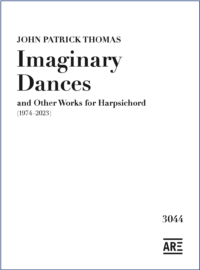Beschreibung
John Patrick Thomas
For Two Harpsichords
Pages
For Harpsichord Four Hands
Elegy No. 4
Instructions for Music for Kagel Music for Kagel
Spoken Text 1 and Spoken Text 2
Introduction
I like the sound produced by multiples of the same instrument. I also like the interaction of two people, seated at two instruments or at the same keyboard, realizing a piece of music together. The music in this collection is, I hope, affectionate, grieving, exuberant, and playful. The pieces, dating from 1988 to 2023, were written for a variety of reasons and for different occasions.
I love the classical harpsichord and am continually amazed at the variety of colors it can produce. There is a special tension that comes into play when we hear the sound of the insturment in different contexts. The Ligeti pieces for harpsichord, for example, have an extraordinary effect, in part because they exhibit the sonority of the instrument used by Rameau and the Couperins, but in a completely different musical language.
Why harpsichords in this age of burgeoning technological inventions? During my career as a countertenor, I worked with a number of excellent Early Music harpsichordists who also had an interest in New Music. Over the years, several of these players —beginning with Alan Curtis and William Christie — liked the music I’d written for other instruments and suggested I compose something for the harpsichord. I also met a number of renowned instrument builders who encouraged me, among them William Dowd in Boston and Reinhard von Nagel in Paris.
I think the music of our time is all the music available to us in our global culture, which gives us unprecedented access to music from earlier periods. While I have no interest in emulating historical models in my music, several of the pieces I’ve written were conceived as companions for works from the harpsichord’s great repertoire. Of course, if I had ever had access to an electronic studio or electronic instruments, I would happily have written a great deal of music using new media and technologies. But my life has led me in another direction.
Notes on the Music
Pages (1988 ), for two harpsichords, consists of very restricted, hard-edged musical material, with each section originally intended to fill a single page. In certain cases, however, some of the material spilled over onto a second or third page. The work was written at the request of Christine Daxelhofer and is dedicated to her and Irene Müller-Glasewald. The two of them played the first performance in 1988.
Elegy No. 4 (2002, arranged for four hands in 2023) was originally written for solo piano in memory of Loes Verberne-Schaap (1908-2002), the mother of my colleague and friend the Dutch cellist Marijke Verberne. Loes Verberne-Schaap was a piano teacher who, diminished in her last years, imagined that the nurse helping her at home was a student who had come for instruction. As a result, the nurse received piano lessons for several weeks.
Music for Kagel (2004), also for harpsichord four hands, dates from the first years of the 21st century. I worked with Mauricio Kagel in the 1970s and 1980s and developed great respect for his work as well as affection for him personally. I participated in the premiere of Kagel’s music theater piece Mare Nostrum at the Berlin Festival in 1974. We repeated this work in later years at the opera in Stuttgart, the Avignon Festival, the Festival d’Automne in Paris, and, in a different production, at the operas in Hanover and Lübeck.
In 1983, at Kagel’s request, I prepared an English version of his original German text for performances of Mare Nostrum at the ICA in London. This text has been used subsequently in other productions. Music for Kagel was originally intended as a gift for his 70th birthday in 2001, but was delayed for some years by other activities. In the course of the piece, the instrumentalists say “yes” and “no” in eight languages and deliver remarks concerning the work and aspects of the performance in progress. Music for Kagel also exists in a version for piano four hands.
JPT Hamburg, September 2023
Acknowledgements
I want to express my thanks to Diane and Jan Williams and to Ann Holyoke Lehmann for their help in the preparation of these scores. Richard Rieves and Kristian Nyquist continue to provide assistance in matters large and small. I am also deeply grateful to Christine Daxelhofer, who initiated the composition of two of these pieces, and to her colleagues who have continued to perform my music.
Are 3049






